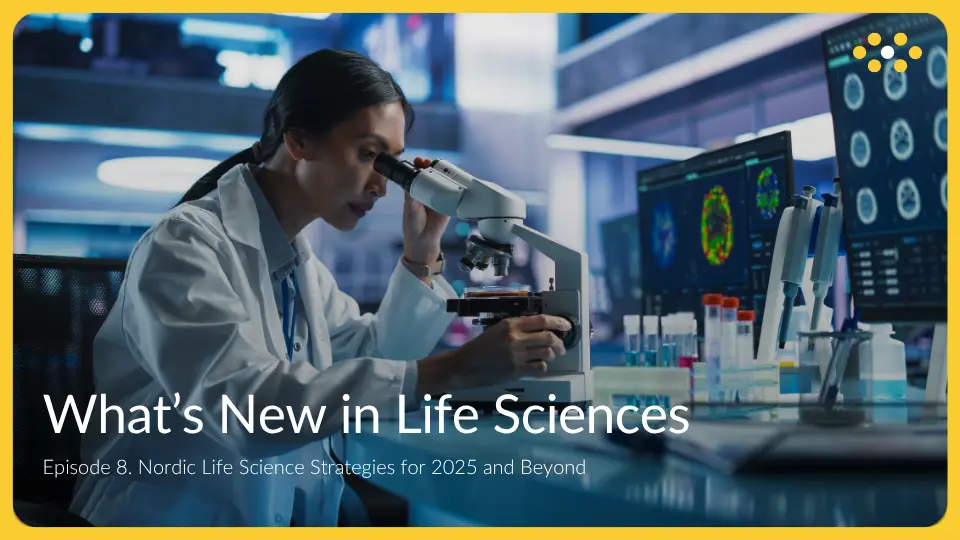The Amoria Bond Group hosted our first ever ASCEND LIVE panel event on International Women’s Day 2021 to provide positive, practical insights and steps both businesses and individuals can make to accelerate greater gender balance in STEM.
It’s no secret that women are significantly underrepresented across most STEM sectors and businesses. The evidence is overwhelming that gender-diverse businesses are more innovative, creative, productive, and profitable. Whilst most companies largely accept and support the need and ‘case’ for change, only a relatively few companies are successfully achieving their objectives and ambitions.
Working closely with our network of STEM clients and professionals, we are excited by the shift in focus away from justifying the ‘why’ to exploring and accelerating the 'how', which is why we brought our expert panellists together to discuss and share:
- How to differentiate your business to effectively attract more female STEM talent
- How to recognise and minimise gender bias in your selection and interview processes
- How women can empower themselves in a male-dominated environment, and how businesses can help
- How to be an effective and positive advocate to achieve greater gender balance in STEM
Hosted by Amoria Bond’s ESG Director, Natasha Crump, and Leah Brown, Group L&D Manager. Our expert panellists were:
Katie Howard-Cross, Founder of Eva Talent and expert consultant in Gender-Based D&I Recruitment & Retention strategies in Global STEM sectors.
Felicity Wingrove, Founder of Zen Communications and a leading expert in the Applied Psychology of Language, Strategic PR and Reputation Manager, and master in empowering communication.
Amy Steel, Associate Director at Coalesce Management Consulting, a recognised and respected specialist in STEM staffing and consultancy solutions with more than 10 years of experience.
We invite and encourage you to watch the full replay here or read on for a summary of our guests’ responses to the questions posed:
How can companies differentiate themselves to attract the female talent they need to thrive and succeed?
Natasha opened by clarifying that this is not about simply attracting more women to tick a box, rather attracting relevant female talent with the skills and experience a business needs.
Advocating a 'show me not tell me' approach, Felicity began by asserting that women need to see themselves authentically reflected in a company brand through strong female role models.
Felicity explained that women are only like to view themselves in a role when they fit 90%-95% of the job description or ‘required skills/experience’; unlike men who generally only look for a 75% match to consider themselves a suitable fit. Highlighting the importance of recognising that 'your truth is not the truth', Felicity referenced the patriarchal paradigm in which businesses display unconscious masculine biases that could potentially deter women from applying for roles.
Felicity recommended using deliberately vague language in job descriptions and placing a deeper focus on the required outcomes from a role and the specific skill sets these required. She also advised that businesses must adjust their language to be more gender-neutral.
How can I attract more female professionals to my business?
Amy was quick to point out that in her experience, the key to attracting more professional women is to harness your existing female workforce, recommending publishing case studies of females already working within your business, and showcasing inspirational female role models through your marketing, website, and social media channels so women can see themselves reflected in your employer brand, and be confident you can provide an inclusive workplace culture.
STEM businesses must be pro-active in breaking down stereotypes by outlining their clear inclusion agenda and can help empower women through facilitating female networking and open conversations. A shared objective is key in creating a truly inclusive environment; as Amy asserted, the key is to work with suppliers who have the same D&I agenda as yourself and be mindful that marginal gains add up to successfully achieving sustainable gender diversity in your business.
Speaking on the benefits of widening the candidate talent pool, Katie advised that STEM companies need to think creatively outside of the box and look outside of their sectors to truly attract and source the female talent they need to thrive; given the disproportionately low number of women working in the sector in the first place, the numbers don’t add up if companies continue to ‘fish from the same pond’ they cannot expect to see a different result.
How can companies create a fair hiring and selection process?
Identifying and recognising individuals’ and procedural hiring bias is an important first step in levelling the playing field for women, said Katie, as this awareness allows you to understand where your organisation needs to focus to change this. She went on to assert that to ensure a fair recruitment process, businesses must be objective in testing candidates’ suitability over likeability for a role.
Candidate selection should be anonymous, with interviews taking place at the latest stage possible. Unconscious biases can occur when an individual favours those similar to themselves and is often a common obstacle during the early stages of the hiring process; people with ethnic minority backgrounds have to send out, on average, 60 % more job applications in order to secure an interview with employers compared to their white counterparts. To overcome this, Katie recommended to ‘ask situational interviewing questions which explore candidates’ experience, knowledge, and motivations.’
Katie recommended pre-defining successful interview answers along with embracing a more dynamic interview panel featuring varying genders, departments, and tenures of staff. Businesses should also deliberately use gender-neutral language in their job adverts and consciously avoid gendered language in interviews that may alienate female candidates.
Does unconscious bias training work to reduce hiring bias?
When asked about recent media coverage questioning its impact in achieving sustainable organisational change, Katie described how unconscious bias training can be a valid and useful awareness tool when delivered as part of a wider program to reduce bias from an organisation’s selection and hiring processes and improve their diversity and inclusivity.
How can I remove gender bias from my hiring process?
Katie was clear – it is not possible to remove gender bias completely, but by identifying and understanding your biases, you can take steps to mitigate their impact on hiring decisions and when promoting staff.
Reinforcing much of the theory Katie had described, Amy shared several practical steps her own company, Coalesce, has taken as part of their D&I program following companywide unconscious bias training, including changing the language used in interviews; and involving more female colleagues, as well as colleagues from other departments, in the interview process to ensure a more diverse interview panel. Amy also described the positive impact of sending a ‘welcome video’ to prospective and new female employees from senior women in the business which provides an overview of the company’s D&I program and the specific initiatives in place for female employees. Amy revealed the positive impact this approach has had and went on to assert that it is essential for companies to be honest about the reality of the situation and the journey you are on – the fact gender diversity is on the agenda is great and shows prospective female employees that they can play a huge part in shaping that journey.
Our panellists were unanimous in their agreement that honesty and authenticity are essential; Natasha agreed that organisations should not pretend to be something they’re not, or more diverse than they already really are.
How can I empower and retain women in my business?
Speaking about Amoria Bond’s own internal ASCEND program, Leah commented that, through ASCEND, we've been able to provide all women across the business regardless of their role, experience, or tenure with access to strong female role models. Pro-actively encouraging and facilitating female colleagues to connect in this way can be very empowering; providing a ‘safe space’ for women to be open about their experiences and challenges, and share learning, resources, and experiences. Leah shared how Amoria Bond had seen tangible progress since launching ASCEND, including improved female retention, the appointment of a second female Board Director, and 50:50 female/male hiring in Q1 this year.
Felicity Wingrove highlighted the importance of empowering women across all levels of your business. She shared how differing inherent communication methods can unconsciously engender and encourage specific responses and explained how women can empower themselves through non-verbal communication, saying purposefully crafting your communication and body language style will punctuate what you say which can be fabulously self-empowering.
Felicity demonstrated the power of subtle changes to hand gestures and body language, referencing Virginia Satir’s five communication categories, Felicity demonstrated a common ‘placator’ hand gesture often adopted by women and explained how unconsciously disempowering it can be – check out this clip:
Felicity asserted that communication styles are unique to every individual and encouraged both men and women to understand their body language and consciously craft their own communication style.
Natasha recommended attendees to check out Felicity’s free Language and Communications Mastery bite-sized vlogs at linkedin.com/in/felicitywingrove
What are the best tools and technologies to identify and reduce hiring bias?
Advancements in technology have made it easier than ever for companies to recognise and reduce hiring bias, asserted Katie, who specifically recommended Enterlo, Connectifier, Unity, Text.io, Picnic, Gamification Summit and BeApplied. WebCrawler software allows employees to find candidates beyond their usual talent pools.
Advising how to effectively use these tools, Katie recommended that businesses should define the different metrics they wish to measure and then proceed to choose the appropriate tool.
How can I be an effective ally for my female colleagues?
Felicity highlighted the importance of education in identifying and reducing gender biases within the workplace, sharing the example of gendered language markers, which can often be interpreted differently leading to miscommunication and misunderstanding; women often punctuate conversation with affirming words or phrases like “yes” or “aha” simply to indicate they are listening or supporting the speaker’s right to speak, but men commonly misinterpret such phrases as indicating agreement with what is being said.
Creating conscious awareness allows both men and women to ‘master their communication’; women can choose to clean up their language, for example replacing “yes” with “I see”, and men can recognise that women have a very different inherent communication style.
How can STEM companies provide truly inclusive workplaces for women?
Felicity asserted that inclusion and diversity training is vital in effectively allying and empowering women to speak freely and confidently.
Amy was equally clear, that to create a truly inclusive environment, STEM companies must reflect on the day-to-day reality of their working practices. She observed that anxiety still exists over unconscious masculine stereotyping, however, the engineering industry continues to progress and embrace the expertise and skillsets of women. Communication is key in advocating for women through educating the wider company and recognising the need for equality within a business. Highlighting the benefits of a dynamic workforce, Amy concluded, ‘businesses with diverse and dynamic workforces are by far the most successful.’
True inclusivity can only be achieved through conscious efforts from everyone within a business, Natasha Crump reflected, as she drew the live session to a close; all colleagues should have the same equity of opportunity to succeed and progress throughout their careers.
AMORIA BOND: PROGRESSING LIVES EVERYWHERE
ASCEND is an internal Group-wide initiative within Amoria Bond designed with the goal of attracting, retaining, and progressing more females within our own business, and across the STEM sectors, we operate in. To find out how Amoria bond can support your business in achieving your gender diversity goals, contact us today!






